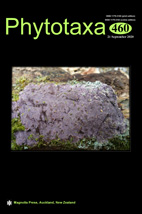Abstract
Rhaphiolepis indica (L.) Lindl. var. umbellata (Thunb.) H. Ohashi is a rosaceous shrub distributed mainly on the seashore of warm-temperate, subtropical to tropical areas of Japan, Korea, China, Philippines, and Borneo (Nakanishi 2018). This plant has been used for greenings of parks, gardens and streets in Japan. The occurrence of an aecial stage of a rust fungus on its shoots and leaves was observed near seashore of Chiba and Ibaraki Prefectures and Bonin (Ogasawara) Islands, Japan in early summer of 2017, 2019 and 2020 (Figs. 1A, B). Morphological observations were made for the identification of this rust fungus with light microscopy by the same method reported by Kasuya & Ono (2018). Spermogonia were not found on specimens. Aecia surrounded with peridia (Figs. 1C, D) were hypophyllous, often gregarious on hypertrophied lesion along veins, rounded or elliptical, cupulate, and 100–300 μm in diam. Their margins were revoluted, lacinate, and white. Peridial cells (Fig. 1E) were firmly conjunct, 20–25 × 15–20 μm in size, outer walls were striate, and 4–7 μm thick, inner walls were verrucose, and 2–3 μm thick. Aeciospores (Fig. 1F) were angularly globose, subglobose to ellipsoid, and 15–22 × 14–20 μm (av. 19 × 17 µm; n = 30) in size. Their walls were almost hyaline, finely verrucose with big granules (appendages or pore plugs), and 1–2 μm thick. The above morphological characteristics were almost identical with descriptions of Aecidium raphiolepidis Sydow (1922: 61) by Ito (1950), Sato (1975) and Hiratsuka et al. (1992) although the size of peridial cells was a little smaller than that of their descriptions. Therefore, the rust fungus on R. indica var. umbellata was identified as A. raphiolepidis. Specimens used in this observation were deposited in the Fungal Herbarium of the Department of Botany, National Museum of Nature and Science, Tsukuba, Japan (TNS).

